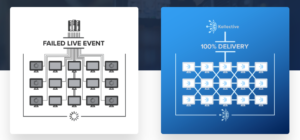When distributing important video communications at scale, Teams Live Events is your organization’s most valuable tool, but buffering can ruin the experience for even the most committed employees. Make sure you keep them engaged by using peer-to-peer streaming to deliver the highest quality video at the lowest possible bandwidth.
How Video Buffering Impacts Employee Engagement
Employee engagement is an important factor in workplace satisfaction and productivity. Interactive live events allow yous to effectively communicate with your team in a way that feels connected and collaborative for employees. When Teams Live Events go off without a hitch, they create an environment that feels more inclusive. However, when buffering is more common than the video itself employee engagement is negatively affected.
As the distribution of live events and enterprise video communication grows, user expectation for high quality will increase as well. According to Understanding the Impact of Video Quality on User Engagement, “a 1% increase in buffering ratio can reduce user engagement by more than three minutes for a 90-minute live video event. We also see that the average bitrate plays a significantly more important role in the case of live content than VoD content.”
IBM Watson Media also says 53% of employees report that video buffering is the largest detriment to workplace productivity, and lagging internet bandwidth is largely to blame.
What Causes Live Video Buffering?
We’ve all experienced the dreaded, seemingly endless buffering icon during an important town hall or CEO update, but why does this happen most often in large, company-wide meetings? It’s simple – unstable internet connectivity due to an overloaded network.
Enterprise organizations with multiple offices and satellite employees understand and have likely dealt with the challenges that come with broadcasting live and on-demand video to a distributed workforce. Most corporate networks do an excellent job handling the demand for one-to-one voice and video calls, but things can – and often do – go south quickly when trying to deliver video messages at scale.
Think of your network like a highway on college football gameday. Every other day of the week, it’s fine; traffic flows seamlessly. But on gameday, the hour before kickoff, traffic is a nightmare. What normally suffices as a two-lane road, needs to be expanded substantially to meet the needs of ticket holders.
The same is true of your network. Without a solution in place to optimize it), the more employees who log on to participate in a live event, the more network bandwidth is needed, which can lead to substantial buffering – or even a crash.
How to Fix Teams Live Events Buffering
The quickest and most scalable way to fix r Teams Live Events buffering is to invest in an enterprise content delivery network (ECDN) powered by browser-based peering.
With a peering solution, your dispersed workforce can stream Teams Live Events without overloading and impacting your network. Browser-based peering uses your existing network – and an intelligent peer-to-peer architecture,to deliver content to your organization more efficiently. No hardware to buy, no software to install. Kollective’s browser-based peering solution scales these communications across your network, allowing you to deliver high-quality live video to your entire organization and achieve 100% delivery at only 1% the bandwidth. It’s so simple you can be up and running in just six clicks.

To see how it works, demo Kollective’s browser-based peering for yourself.
